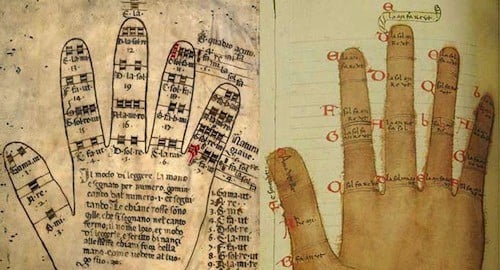In an age of sheet music, pianos, and electronic keyboards, the study of a nearly extinct technique for learning how to sing might seem unwarranted. But Jesse Rodin, an assistant professor of music at Stanford, believes that an antiquated teaching tool reveals much about a faculty that has arguably been neglected in this era of instant access to information: memory.
The Guidonian Hand was a musical staple of medieval clergymen, choirboys, and composers. A map of notes arranged on the hand, it was used to help aspiring singers remember how musical notes relate to one another. Had you watched a church choir perform 500 years ago in France, the Low Countries or Italy, you could be certain that the singers had used the Hand, at least in their formative years.
Gaining insight into this method of learning reveals much about the thought processes of people who lived during one of the most intellectually vibrant eras of human history, says Rodin, which is why it merits study not only by music scholars, but by anyone who wants to better understand the origins of music.
“Most undergraduates who pursue music degrees encounter the Guidonian Hand, but hardly anyone learns how to use it,” says Rodin, who recently hosted a symposium on the Hand with the help of his students. The conference included a performance in which Rodin and several students demonstrated the practice by singing a piece of four-voice a cappella music from the late 15th century.
“The Guidonian Hand is the ancestor of our modern system of music theory,” he says. “I mean, The Sound of Music could not have existed without the Hand. Instead of ut re mi we now say do re mi, but otherwise the two systems are very similar.”
Developed in the 11th century, the Guidonian Hand is a mnemonic system in which musical “steps” are arranged in a spiral across twenty joints on the left hand. Like the alphabet, it was a basis for understanding relationships between different characters – in this case, musical notes (ut, re, mi, fa, sol, and la). It’s not certain whether medieval singers used the Hand during performance, but we can be sure their musical thinking was informed by it.
“It’s a way of navigating tonal space effectively,” explains Rodin, who with his students demonstrated the Hand as part of a performance of four-voice a cappella music for the Mass.
“If you’re a violinist and it’s time to play a piece, you put your finger on a certain place on the violin, and, with the help of a bow, the instrument makes a sound,” he says. “If you’re a singer, you can’t do that. Vocal utterances don’t have physical locations. So the Hand is effectively a fingering system for the voice. It’s a way of assigning each frequency or relation of frequencies a physical place on the body.”
Rodin has been working with fellow scholars from Stanford – including some whose academic expertise lie far outside musicology –to trace the origins of the Guidonian Hand. These scholars have also been considering the theoretical and practical implications of how and why composers moved beyond the Hand, beginning in the fifteenth century, as composers pushed at the limits of the theoretical system.
Students Find New Meaning in Centuries-Old Techniques
“I think that the experience of singing using the Hand is a huge part of my enjoyment, because you feel ownership of the material,” says Victoria Chang, a fourth year graduate student in physics who was introduced to the Guidonian Hand while watching Rodin’s vocal group – Cut Circle – performing during her second year at Stanford.
“It’s like I forgot for a long time that I wanted to do music, and then suddenly remembered,” says Chang, who will be entering the Ph.D. program in musicology this fall after having completed her Master’s.
“There are people, including people in my own family, who are completely shocked that there was music before Mozart and Bach,” says Clare Robinson, a second-year musicology Ph.D. student whose research has largely focused on fifteenth-century music.
“I wasn’t originally going to study music in college. I was studying linguistics, but I somehow couldn’t stay away from it,” she recalls, noting how access to manuscripts and print sources from the time period served as a further catalyst. “It wasn’t until I did a research project working on primary materials and primary sources that I really felt some sort of connection between the music that I loved listening to so much and the scholarship behind it.”
“I think it’s very important to increase awareness of earlier musical repertoires,” says Robinson.
“Whereas students of painting and sculpture can go to a museum and see surviving examples from the middle ages and renaissance, we have no direct access to what performances of music in those periods sounded like,” says Rodin. “And in this country, few students are exposed to music before 1700 at any point in their studies. So these extraordinarily rich musical worlds are simply unknown to most people.”


